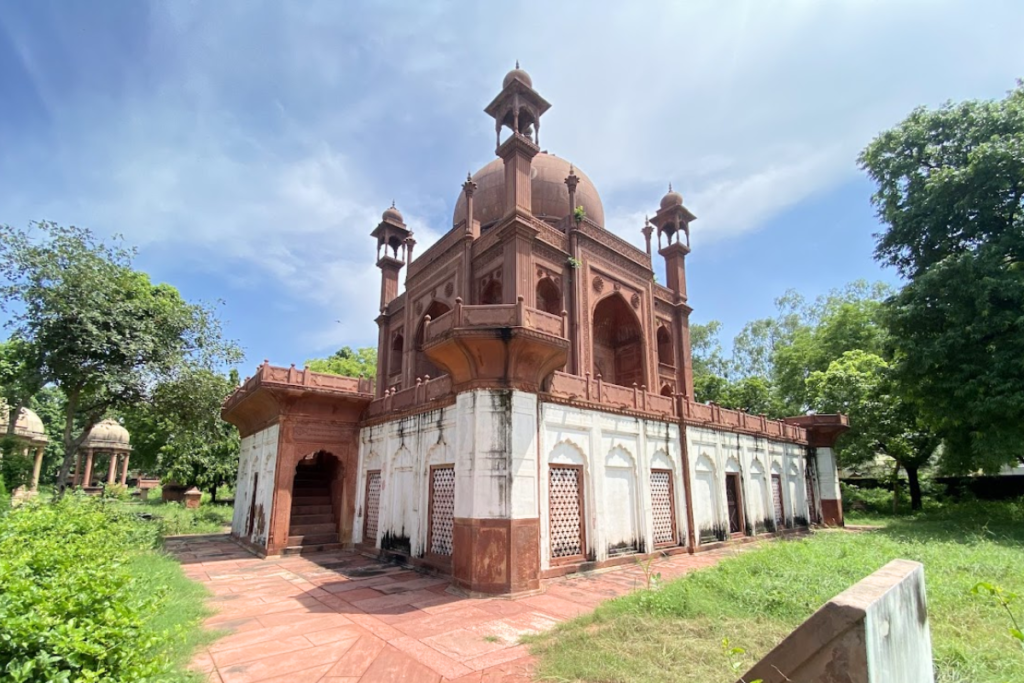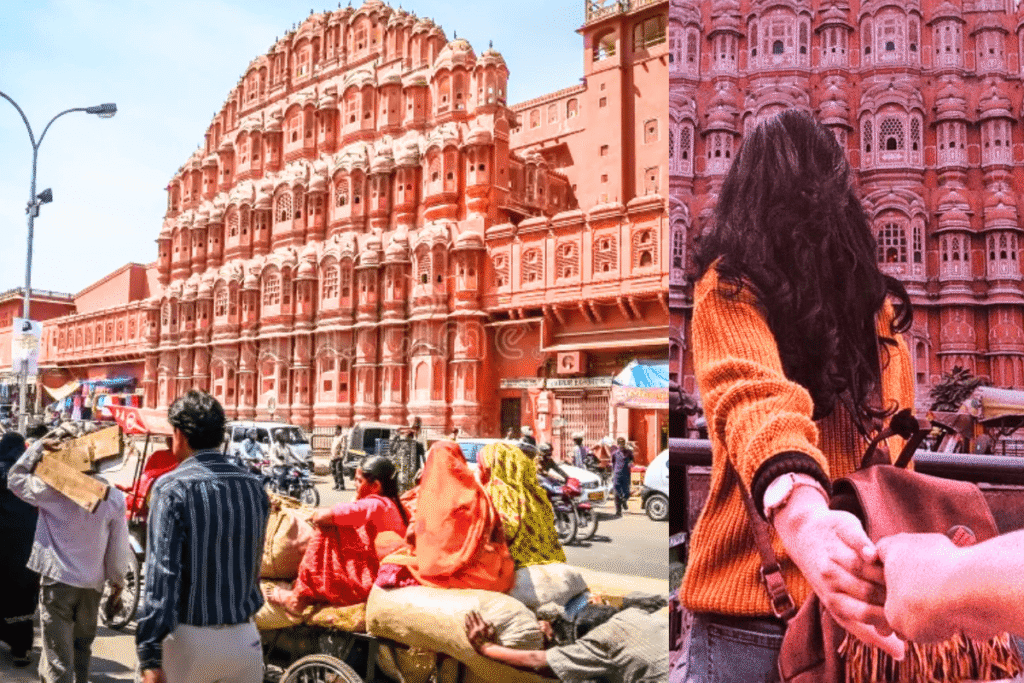Red Taj Mahal Agra: When we think of Agra, the first image that comes to mind is the gleaming white marble of the iconic Taj Mahal, built by Shah Jahan in memory of his beloved wife, Mumtaz Mahal. But few know that Agra houses another monument of love—similar in design but built with red sandstone. This hidden gem is the Red Taj Mahal, also known as the John Hessing Tomb, and it tells a story just as poignant, though lesser-known. This is a monument not built by an emperor for his queen but by a devoted wife for her husband, a Dutch soldier who served in India.

Red Taj Mahal Agra: A Miniature Taj of Love and Loss
Located within the tranquil Catholic Cemetery of Agra, the Red Taj Mahal is a stunning but often overlooked monument. While the world flocks to the grand Taj Mahal, this smaller version stands quietly amidst greenery, waiting to share its unique tale with those willing to explore the city beyond its famous sites. The tomb mirrors much of the Mughal architectural style seen in the Taj Mahal—its arches, domes, and symmetrical design are all inspired by the original. However, it’s crafted from red sandstone instead of white marble, giving it a warm, earthy hue that contrasts with the gleaming Taj.
While its structure may seem like a scaled-down version of the Taj Mahal, the Red Taj Mahal holds a very different emotional resonance. Built by Ann Hessing in memory of her husband, John Hessing, this tomb is a rare example of a wife commemorating her husband in a time and culture where monumental tributes were often made by men for their wives.
Read More: The Fascinating Taj Mahal Story
Red Taj Mahal Agra: The Story of John Hessing: A Soldier and a Hero

So who was John Hessing, and why is he memorialized in such a grand fashion? Born in the Netherlands, Hessing was one of the many European adventurers and mercenaries who made their way to India during the 18th century. After initially serving under the Nizam of Hyderabad, he found his way to the Maratha Empire, where his loyalty and military prowess earned him the command of the Agra Fort in 1799, under the leadership of Daulatrao Scindia.
John Hessing’s military career, however, came to a tragic end in 1803 during the Second Anglo-Maratha War, when the British army attacked Agra. Hessing, ever the valiant soldier, defended the fort with all his might but ultimately lost his life in battle. His death left his wife, Ann Hessing, devastated. It was out of her profound grief and love that Ann decided to build a memorial for him—a tribute to the man who had fought valiantly in a foreign land and won the hearts of many.
Red Taj Mahal Agra: A Monument Built on Love and Limited Resources
Ann Hessing, much like Shah Jahan, envisioned a monument for her beloved that would echo the grandeur of the Taj Mahal. However, unlike the Mughal emperor, Ann’s resources were far more limited. With just Rs. one lakh at her disposal, she could not afford the white marble that gives the Taj Mahal its ethereal beauty. Instead, she turned to red sandstone, a material widely available and used in Mughal architecture.
Though she faced financial constraints, Ann Hessing ensured that the tomb would still reflect the architectural brilliance of its inspiration. The Red Taj Mahal is topped with red cupolas and small chhatris (elevated, dome-shaped pavilions), similar to those on the Taj. The double dome of the tomb is a marvel in itself, crowned with a kalash finial and lotus petal sheaths, both of which are classic elements of Mughal design.
One noticeable difference is the absence of the four iconic minarets that flank the Taj Mahal. While Ann had planned for them, she could not complete them due to her limited budget. Even so, the tomb is perfectly balanced in its proportions, exuding a quiet elegance that is both touching and beautiful.
Day Tour to Agra from Delhi with Taj Mahal Tour Guide
Red Taj Mahal Agra: A Blend of Cultures and Faiths
The Catholic Cemetery of Agra, where the Red Taj Mahal is located, is one of the oldest Christian burial grounds in India. Interestingly, despite its Christian roots, many of the tombs and monuments within the cemetery bear distinct Mughal influences, showcasing the cultural syncretism of the time. The Red Taj Mahal is a perfect example of this fusion of faiths and styles. Although it is the tomb of a Dutch Christian soldier, its architectural form is unmistakably Mughal.
Inside the tomb, there are two inscriptions in Persian. One expresses the deep grief Ann Hessing felt at the loss of her husband, while the other marks the year of his death. This blending of European and Indian elements makes the Red Taj Mahal not only a monument to love but also a symbol of the rich cultural exchange between India and Europe during this period.
Exploring the Red Taj Mahal Agra Today
Today, the Red Taj Mahal is far from the bustling crowds that throng the white Taj Mahal. Instead, it offers a peaceful retreat for those who seek to delve deeper into Agra’s history. Hidden away in the heart of the city, this monument is an oasis of serenity, surrounded by a lush green garden that adds to its charm.
Visitors to the Red Taj Mahal are often struck by its simplicity and beauty. While it may not have the grand scale of its marble counterpart, it stands as a moving tribute to a love that crossed cultural and geographical boundaries. This monument, much like the Taj Mahal, reminds us that love knows no borders.
One of the most enchanting aspects of the Red Taj Mahal is the feeling of stepping back in time. The cemetery, with its mix of Christian and Mughal influences, tells the story of India’s rich and diverse history. The tombs, marked with crosses and lotus motifs, serve as a testament to the harmony between different cultures and religions during the Mughal era.
A Journey of Love and Discovery through the Golden Triangle
Why Visit the Red Taj Mahal Agra?
While the Taj Mahal will always be the star attraction of Agra, the Red Taj Mahal offers something different—a quieter, more intimate experience that feels like a well-kept secret. For history buffs, the tomb provides a glimpse into the lives of the many Europeans who came to India during the 18th century and became woven into its history.
The Red Taj Mahal is also a photographer’s dream, with its intricate Mughal-style engravings, red sandstone walls, and the peaceful surroundings of the Catholic Cemetery. The blend of Indian and European influences makes it a unique spot, perfect for those who wish to capture a different side of Agra.
Conclusion
The Red Taj Mahal may not be as well-known as its famous white counterpart, but it is just as rich in history and emotion. Built by a grieving wife in memory of her beloved husband, this hidden gem stands as a testament to love, sacrifice, and cultural fusion. As you explore the Red Taj Mahal, you’ll find yourself transported to a time when Agra was not just the city of emperors and queens, but also a place where European soldiers and adventurers left their mark.
For travelers seeking to uncover the lesser-known stories of Agra, the Red Taj Mahal is a must-visit. It offers a serene and reflective experience, away from the crowds, allowing you to connect with a story of love that spans continents and centuries.







